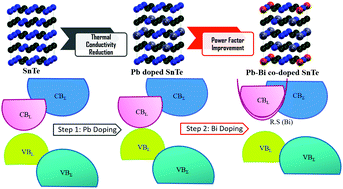Improving the ZT of SnTe using electronic structure engineering: unusual behavior of Bi dopant in the presence of Pb as a co-dopant
Abstract
Electronic structure engineering of SnTe by doping various elements to improve its figure of merit has been the most promising approach recently sought after. Pb doped in SnTe is well known to decrease the thermal conductivity but fails to beneficially tune its electronic properties. Herein, we co-dope Bi in SnTe doped with Pb, to improve the power factor of the material. Bi in the presence of Pb exhibits unusual features not shown in the case of Bi doped SnTe. The synergistic action leads to an increase in the band gap and valence band convergence. Bi also introduces resonance states just below the conduction band edge and causes conduction band convergence. An enhanced power factor due to modification of the electronic structure combined with reduced thermal conductivity translates into an enhanced figure of merit of up to ∼1.58 at 800 K as predicted using Boltzmann transport calculations, making it a potential thermoelectric material worthy of further study.

- This article is part of the themed collection: Celebrating International Women’s Day: Women in Materials Science


 Please wait while we load your content...
Please wait while we load your content...